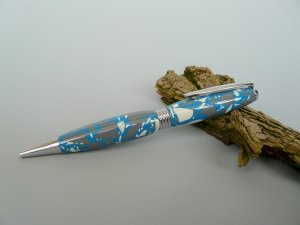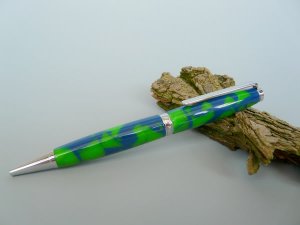soligen
Member
Started turning my first fully cured blanks. First try blew out big time when drilling. then I remebered you are supposed to stop short then cut the blank - much better.
In both these you can see the pits, which is my biggest issue. I just got the Woodchuck yesterday, so was trying it out on these. Is my technique bad, or are the blanks too brittle? My rest is too big so I have trouble getting real close to the blank.
Both these were put in the hot car to cure. The orange one was cast Friday evening, then put in the car all day Saturday while I was out with the wife, then turned Sunday AM (today). It is a 3 color pour (red/orange/yellow) of castin craft PR with Mixol and Mother of Pearl. I poured the colors togehter way too soon, so have crappy seperation - learning!
The blue (single color with the MOP) is from fiberglass resin and was cast last weekend. I had turned a sample of this before it was fully cured and had a smaller issue with tear out - this is much worse.
I had a 3rd (not pictured) blue with MOP from PR that blew out real bad when drilling. It had the pits like these too.
Is over baking by putting it in a hot car for a day making it too brittle? Or i smy technique a problem? or both?
Other observations:
1) Drilling through the center was excellent - much more accurate than wood
2) A standard twist bit drilled much easier than the brad point bit
3) It helped somewhat to try to "ride the bevel" on the woodchuck, although thats not what the instructions said to do
As it stands now, I would need to do quite a bit of final shaping with sandpaper - which I would rather do with a tool.
Any advice appreciated.
In both these you can see the pits, which is my biggest issue. I just got the Woodchuck yesterday, so was trying it out on these. Is my technique bad, or are the blanks too brittle? My rest is too big so I have trouble getting real close to the blank.
Both these were put in the hot car to cure. The orange one was cast Friday evening, then put in the car all day Saturday while I was out with the wife, then turned Sunday AM (today). It is a 3 color pour (red/orange/yellow) of castin craft PR with Mixol and Mother of Pearl. I poured the colors togehter way too soon, so have crappy seperation - learning!
The blue (single color with the MOP) is from fiberglass resin and was cast last weekend. I had turned a sample of this before it was fully cured and had a smaller issue with tear out - this is much worse.
I had a 3rd (not pictured) blue with MOP from PR that blew out real bad when drilling. It had the pits like these too.
Is over baking by putting it in a hot car for a day making it too brittle? Or i smy technique a problem? or both?
Other observations:
1) Drilling through the center was excellent - much more accurate than wood
2) A standard twist bit drilled much easier than the brad point bit
3) It helped somewhat to try to "ride the bevel" on the woodchuck, although thats not what the instructions said to do
As it stands now, I would need to do quite a bit of final shaping with sandpaper - which I would rather do with a tool.
Any advice appreciated.



